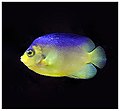Top Qs
Timeline
Chat
Perspective
Centropyge
Genus of fishes From Wikipedia, the free encyclopedia
Remove ads
Centropyge is a genus of ray-finned fish, marine angelfish belonging to the family Pomacanthidae found in the Atlantic, Indian and Pacific Ocean.[2] These species do not exceed 15 cm in length and live in haremic structures with one dominant male and multiple females.[2]
Remove ads
Taxonomy
Centropyge is a paraphyletic genus. This is because Genicanthus and the polyphyletic genus Apolemichthys are nested within Centropyge.[3]
Centropyge includes 3 subgenera and several species complexes. The subgenus Xiphypops only comprises all species within the C. acanthops complex, which include C. acanthops, C. argi, C. aurantonota, C. resplendens. Subgenus Paracentropyge comprises C. boylei, C. multifasciata, and C. venusta. These two subgenera are monophyletic and there is support for their elevation to genus status. All other species currently fall under the nominate subgenus Centropyge, which is not monophyletic. Different studies have designated different species complexes within Centropyge, based on differing definitions of the term 'species complex'.[3]
Remove ads
Biology
Although it is difficult to distinguish the sexes, females are often shorter and more round finned. Like many other reef fish and all marine angelfish, the species in this genus are protogynous hermaphrodites, meaning that they start their adult lives as females and the dominant individual in a group can change to a male within days. A reversal of this sex change is possible if the social status of the individual changes, it is however a process that requires much more time.[4] Uniquely amongst protogynous fish, males of at least one species of Centropyge (C. ferrugata) are capable of reversing sex change and changing back into females.[5]
Remove ads
In aquaria
This genus prefer matured reef tanks due to the usually high water quality and the often used "live rock". In nature most species feed on algae, sponges and small benthic invertebrates. Having an abundance of well cured live rock will help to supplement their diet.[6] This is also in the interest of the aquarist, as underfed Centropyge angels may nip at corals and sessile invertebrates.[7] Dwarf angels can be quite shy initially, hiding in corals, caves and crevices but become more outgoing when they have established their territory - if they are kept with appropriate tank mates and in appropriately sized tanks.[8]
Species
Summarize
Perspective
There are currently 35 recognized species in this genus:[2]
Remove ads
References
Wikiwand - on
Seamless Wikipedia browsing. On steroids.
Remove ads

























